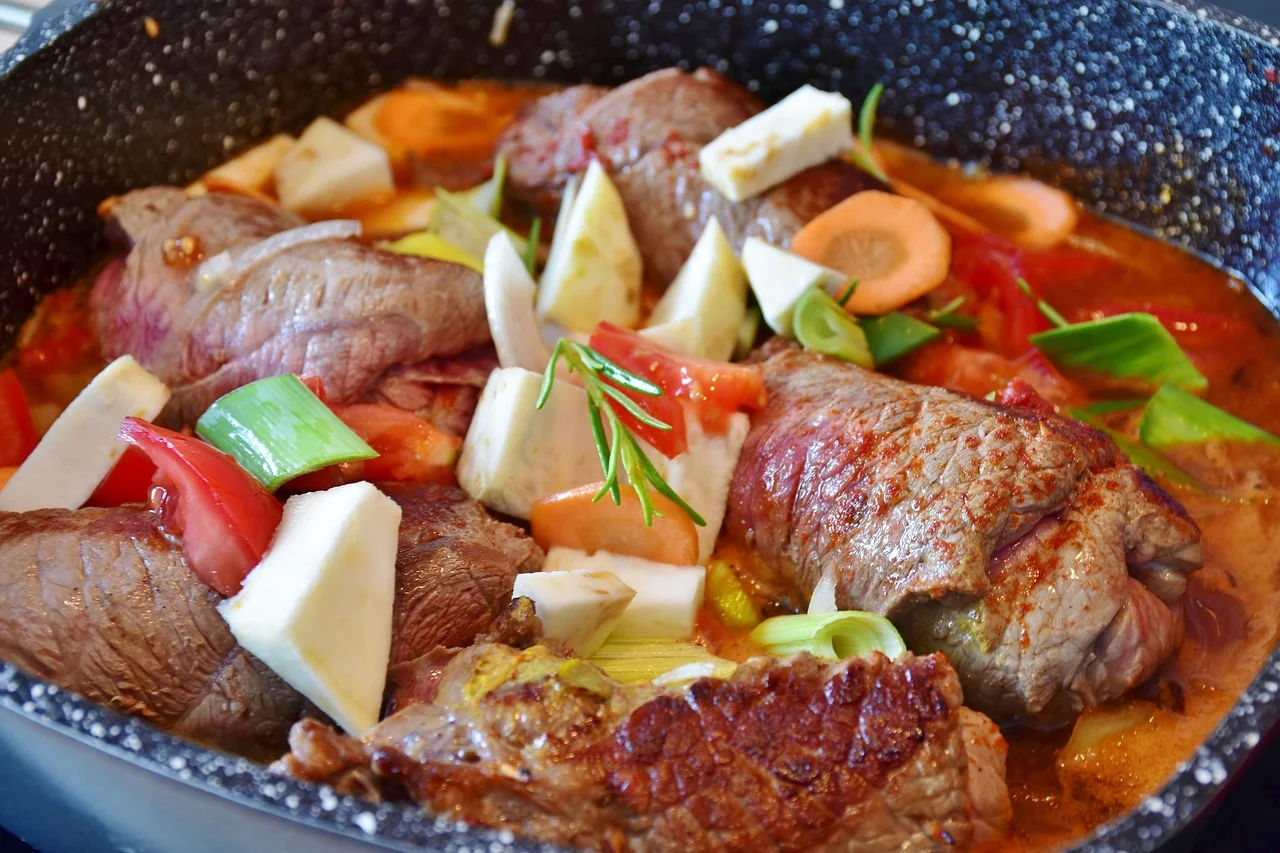Slow cooker recipes are a fantastic way to prepare delicious meals with minimal effort. Whether you’re a busy professional, a parent juggling multiple responsibilities, or simply someone who loves good food, a slow cooker can be your best friend in the kitchen. In this comprehensive guide, we will explore the world of slow cooker recipes, from savory stews to mouthwatering desserts. Let’s dive in and discover the magic of slow cooking!
Benefits of Slow Cooking
Slow cooking offers numerous benefits that make it a popular choice for home cooks. Here are some advantages of using a slow cooker:
- Convenience: With a slow cooker, you can set it and then leave it to do its thing. This means you can prep your ingredients, toss them in the pot, and go about your day while the slow cooker works its magic.
- Enhanced Flavors: Slow cooking allows flavors to meld together over time, resulting in rich and complex dishes that are bursting with taste.
- Tenderizes Tough Cuts: Tough cuts of meat become tender and juicy when cooked slowly, making them perfect for dishes like pot roast and pulled pork.
- Time-Saving: Slow cookers are a time-saving kitchen appliance. You can prepare meals in the morning and come home to a hot, ready-to-eat dinner in the evening.
For more information on the benefits of slow cooking, check out RecipesYumy’s post on the advantages of slow cooking.
Getting Started with Slow Cooking
If you’re new to slow cooking, getting started is easier than you might think. Here are a few tips to help you begin your slow cooking journey:
- Choose the Right Size: Make sure your slow cooker is the right size for the recipe you’re making. A slow cooker that’s too large or too small can affect the cooking time and results.
- Prep Ingredients Ahead of Time: To save time in the morning, prep your ingredients the night before. This way, you can simply dump everything into the slow cooker in the morning.
- Follow Recipes: When starting out, it’s a good idea to follow recipes until you get a feel for how your slow cooker works. Once you’re comfortable, you can start experimenting with your own creations.
For a detailed guide on how to master the art of slow cooking, visit RecipesYumy’s comprehensive slow cooker recipe guide.
Must-Have Ingredients for Slow Cooking
Certain ingredients work exceptionally well in slow cooker recipes, enhancing flavors and textures. Here are some must-have ingredients to keep in your pantry for your slow cooking adventures:
- Root Vegetables: Potatoes, carrots, and parsnips hold up well to long cooking times and add depth to stews and roasts.
- Dried Herbs and Spices: Herbs like rosemary, thyme, and bay leaves, along with spices such as cumin, paprika, and cinnamon, can elevate the flavors of your dishes.
- Broths and Stocks: Chicken, beef, or vegetable broths are essential for creating flavorful bases for soups and stews.
- Beans and Lentils: These protein-packed ingredients are perfect for hearty vegetarian dishes like chili and curries.
Stay tuned for the next part of our guide, where we’ll delve into specific slow cooker recipes for every occasion!
What Cannot Be Cooked in a Slow Cooker
- Raw Pasta: Pasta needs to be boiled in water to achieve the desired texture.
- Quick-Cooking Vegetables: Vegetables such as spinach and peas can become mushy when cooked for prolonged periods.
- Dairy Products: Dairy products like milk and cheese can curdle when exposed to prolonged heat.
- Breaded Meats: Coatings on breaded meats may become soggy instead of crispy.
- Rice: Rice requires precise water-to-rice ratios and cooking times that slow cookers may not accommodate.
- Frozen Foods: Slow cookers may not heat frozen foods to safe temperatures quickly enough, risking bacterial growth.
Alternative Cooking Methods
- Boiling: For foods like pasta and rice, boiling in water on the stovetop is the preferred method.
- Sautéing or Pan-Frying: Achieve crispy textures with breaded meats by sautéing or pan-frying in oil.
- Baking or Broiling: For dishes requiring high heat, such as casseroles, baking or broiling in the oven ensures proper cooking.
- Steaming: Steam vegetables to retain their crispness and nutrients without overcooking.
Safety Concerns
When using slow cookers, it’s crucial to follow safety guidelines to prevent foodborne illnesses. Ensure that meats reach a safe internal temperature, and avoid leaving perishable foods at room temperature for too long.
Tips for Successful Slow Cooking
- Prep Ingredients Properly: Cut meats and vegetables into uniform sizes for even cooking.
- Use the Right Size Slow Cooker: Avoid overfilling or underfilling the slow cooker to ensure proper cooking.
- Add Ingredients Wisely: Layer ingredients according to cooking times, placing tougher cuts of meat at the bottom.
- Monitor Cooking Time: Avoid overcooking by following recommended cooking times and adjusting as needed.
- Season Appropriately: Flavors can intensify during slow cooking, so adjust seasonings accordingly.
Must-Have Ingredients for Slow Cooking
Slow cooking is all about creating rich, flavorful dishes with minimal effort. To achieve delicious results, it’s essential to have the right ingredients on hand. Let’s explore some key ingredients that are essential for successful slow cooker recipes:
Root Vegetables
Root vegetables like potatoes, carrots, and parsnips are staple ingredients in slow cooker recipes. These hearty vegetables hold up well to long cooking times, developing a deep, earthy flavor and a tender texture. They are perfect for adding substance to stews, soups, and roasts, enhancing the overall richness of the dish. Additionally, root vegetables are versatile and can be used in a wide range of recipes, making them a must-have in any slow cooker pantry.
Dried Herbs and Spices
Dried herbs and spices play a crucial role in elevating the flavors of slow cooker dishes. Ingredients like rosemary, thyme, and bay leaves add a fragrant aroma to savory dishes, while spices such as cumin, paprika, and cinnamon bring warmth and depth to your recipes. These seasonings help create a well-balanced and complex flavor profile, making your slow cooker meals more vibrant and satisfying. Experimenting with different herbs and spices can also add variety to your cooking, allowing you to customize dishes to your taste preferences.
Broths and Stocks
Broths and stocks are essential for creating flavorful bases in slow cooker recipes. Whether you’re making a hearty soup, a savory stew, or a braised meat dish, having a good-quality broth on hand can enhance the overall taste of your meal. Chicken, beef, or vegetable broths provide a rich and savory foundation for your dishes, infusing them with depth and complexity. Additionally, broths and stocks can help tenderize meats and vegetables during the cooking process, resulting in tender, juicy, and flavorful end products.
Beans and Lentils
Beans and lentils are versatile ingredients that add protein, fiber, and texture to slow cooker recipes. Whether you’re making a vegetarian chili, a hearty curry, or a savory stew, beans and lentils can bulk up your dishes and make them more filling and satisfying. These legumes can withstand long cooking times, absorbing flavors and becoming tender and creamy. Additionally, beans and lentils are budget-friendly and nutritious, making them a healthy addition to your slow cooker repertoire.
By stocking your pantry with root vegetables, dried herbs and spices, broths and stocks, and beans and lentils, you’ll be well-equipped to create delicious and satisfying slow cooker meals. These essential ingredients provide the foundation for a wide range of recipes, allowing you to experiment and get creative in the kitchen. Happy slow cooking!
What Cannot Be Cooked in a Slow Cooker
Dairy products and cheese
Dairy products, such as milk, cream, and cheese, can curdle or separate when cooked for extended periods in a slow cooker. It’s best to add dairy-based ingredients towards the end of the cooking process or use alternatives like coconut milk.
Pasta and rice
Pasta and rice can become mushy and overcooked in a slow cooker, resulting in an undesirable texture. It’s recommended to cook pasta and rice separately and add them to the dish just before serving.
Seafood and delicate proteins
Seafood and delicate proteins like fish and shellfish can easily overcook and become rubbery in a slow cooker. These ingredients are best cooked using faster methods to preserve their texture and flavor.
Fresh herbs and certain spices
Fresh herbs and delicate spices can lose their flavor when cooked for extended periods in a slow cooker. It’s advisable to add these ingredients towards the end of the cooking process or use dried herbs and spices instead.
Baking and crispy foods
Slow cookers are not suitable for baking or achieving crispy textures, as they do not provide the dry heat required for these cooking methods. It’s best to use traditional baking or frying methods for such dishes.
Safety Concerns and Tips
Importance of food safety in slow cooking
While slow cookers are convenient, it’s crucial to prioritize food safety to prevent the growth of harmful bacteria. Ensure that ingredients are stored and handled properly before cooking.
Tips to avoid foodborne illnesses
Thaw frozen ingredients before adding them to the slow cooker, and avoid leaving cooked food sitting in the pot for an extended period. Use a food thermometer to make sure that meats reach a safe internal temperature.
Proper handling of ingredients
Wash hands, utensils, and surfaces thoroughly before and after handling ingredients. Store perishable ingredients in the refrigerator until ready to use, and discard any leftovers that have been sitting at room temperature for more than two hours.
FAQs Section « What cannot be cooked in a slow cooker? »
Can you cook frozen meat in a slow cooker?
While it’s possible to cook frozen meat in a slow cooker, it’s not recommended due to safety concerns. Thawing meat before cooking ensures more even cooking and reduces the risk of bacterial growth.
Is it safe to leave a slow cooker unattended?
While slow cookers are designed to cook food safely over long periods, it’s generally not advisable to leave them unattended for extended periods. Check the manufacturer’s instructions for recommended cooking times and safety guidelines.
How long can food stay in a slow cooker?
Cooked food can typically remain in a slow cooker on the « warm » setting for up to two hours before serving. After that, it’s best to transfer leftovers to the refrigerator to prevent bacterial growth.
Alternatives to Slow Cooking
- Oven-baking: Oven-baking is a versatile cooking method that can replicate slow cooking results. It allows for even heat distribution, making it suitable for dishes like roasts, casseroles, and braised meats. While it may require a longer cooking time compared to other methods, it can produce similar tender and flavorful results.
- Pressure cooking: Pressure cooking is a fast and efficient cooking method that uses steam pressure to cook food quickly. It’s ideal for busy individuals who want to enjoy slow-cooked dishes in a fraction of the time. Pressure cookers can tenderize tough cuts of meat and infuse flavors into dishes rapidly. Additionally, they retain more nutrients compared to other cooking methods due to shorter cooking times.
- Stovetop cooking: Stovetop cooking offers more control over temperature and cooking time, making it suitable for a wide range of recipes. It’s particularly useful for dishes that require constant monitoring, such as soups, stews, and sauces. With stovetop cooking, you can adjust the heat levels to achieve the desired texture and flavor, whether it’s simmering, sautéing, or boiling. While it may not be as hands-off as slow cooking, stovetop cooking allows for quicker preparation and cooking of meals without sacrificing taste or quality.

